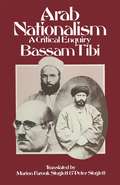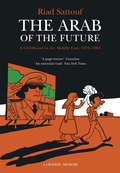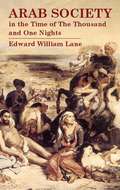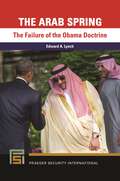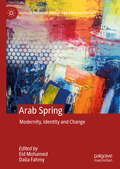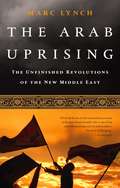- Table View
- List View
Arab Nationalism in the Twentieth Century: From Triumph to Despair (PDF)
by Adeed DawishaLike a great dynasty that falls to ruin and is eventually remembered more for its faults than its feats, Arab nationalism is remembered mostly for its humiliating rout in the 1967 Six Day War, for inter-Arab divisions, and for words and actions distinguished by their meagerness. But people tend to forget the majesty that Arab nationalism once was. In this elegantly narrated and richly documented book, Adeed Dawisha brings this majesty to life through a sweeping historical account of its dramatic rise and fall. Dawisha argues that Arab nationalism--which, he says, was inspired by nineteenth-century German Romantic nationalism--really took root after World War I and not in the nineteenth century, as many believe, and that it blossomed only in the 1950s and 1960s under the charismatic leadership of Egypt's Gamal 'Abd al-Nasir. He traces the ideology's passage from the collapse of the Ottoman Empire through its triumphant ascendancy in the late 1950s with the unity of Egypt and Syria and with the nationalist revolution of Iraq, to the mortal blow it received in the 1967 Arab defeat by Israel, and its eventual eclipse. Dawisha criticizes the common failure to distinguish between the broader, cultural phenomenon of "Arabism" and the political, secular desire for a united Arab state that defined Arab nationalism. In recent decades competitive ideologies--not least, Islamic militancy--have inexorably supplanted the latter, he contends. Dawisha, who grew up in Iraq during the heyday of Arab nationalism, infuses his work with rare personal insight and extraordinary historical breadth. In addition to Western sources, he draws on an unprecedented wealth of Arab political memoirs and studies to tell the fascinating story of one of the most colorful and significant periods of the contemporary Arab world. In doing so, he also gives us the means to more fully understand trends in the region today.Complete with a hard-hitting new and expanded section that surveys recent nationalism and events in the Middle East, Arab Nationalism in the Twentieth Century tells the fascinating story of one of the most colorful and significant periods in twentieth-century Middle Eastern history.
Arab Nationalism (pdf): A Critical Enquiry
by Bassam Tibi Peter Sluglett Matt DeLisi Ed trans Marion Farouk-SluglettThe Arab Nationalist Advisor: Yusuf Yassin of Saudi Arabia
by Joseph A. KéchichianShaykh Yusuf Yassin (18921962) marked the contemporary history of the Kingdom of Saudi Arabia in his capacity as a favorite advisor who was the founder monarchs confidential secretary, relentless envoy and chief foreign policy consultant. Born in Latakiyyah, Syria, Yassin earned the confidence of King Abdul Aziz bin Abdul Rahman Al Saud, and moved to Riyadh even before the Third Saudi Kingdom was inaugurated in 1932. After obtaining citizenship he participated in critical decisions reached by the ruler as regional and international actors honed in on the wealth of the Arabian Peninsula. Over the course of several decades Yusuf Yassin met with and negotiated on behalf of three monarchs, Abdul Aziz and his two successors, Saud and Faysal, with Arab and global leaders. He was present at the creation of the country and suggested that al-Saudiyyah be added to its very nameAl-Mamlakah al-Arabiyyah al-Saudiyyahwhich reflected his personality and political outlook as an Arab nationalist who cherished the founder. Joseph Kechichian has written the first political biography of the statesman, based on original documents [the Yassin Papers] as well as Western diplomatic correspondence. Kechichian provides insights into the Nationalist Al Saud Advisor who left his mark on Saudi Arabia. The volume provides essential background on a man who rose from humble origins in Syria to espouse Arabian values, and walks the reader through nearly five decades of Arab history, including the repercussions of the infamous 1916 SykesPicot Agreement, the creation of the League of Arab States, and various Arab crises. These events, experienced and engaged with by Shaykh Yusuf Yassin at the highest political and diplomatic levels, set the stage that empowered Saudi Arabia, along with other Arab States, with the wherewithal to succeed for their respective peoples.
The Arab of the Future: Volume 1: A Childhood in the Middle East, 1978-1984 - A Graphic Memoir (The Arab of the Future #2)
by Riad SattoufVOLUME 1 IN THE UNFORGETTABLE STORY OF AN EXTRAORDINARY CHILDHOODA GUARDIAN BOOK OF THE YEAR 2015/2016 | AN OBSERVER GRAPHIC BOOK OF THE YEAR 2016 | A NEW YORK TIMES CRITICS' TOP BOOKS OF 2016 'EXUBERANTLY HERETICAL''I tore through it... The most enjoyable graphic novel I've read in a while' Zadie Smith'I joyously recommend this book to you' Mark Haddon'Riad Sattouf is one of the great creators of our time' Alain De Botton'Beautifully-written and drawn, witty, sad, fascinating... Brilliant' Simon Sebag MontefioreThe Arab of the Future tells the unforgettable story of Riad Sattouf's childhood, spent in the shadows of three dictators - Muammar Gaddafi, Hafez al-Assad, and his father.In striking, virtuoso graphic style that captures both the immediacy of childhood and the fervor of political idealism, Riad Sattouf recounts his nomadic childhood growing up in rural France, Gaddafi's Libya, and Assad's Syria - but always under the roof of his father, a Syrian Pan-Arabist who drags his family along in his pursuit of grandiose dreams for the Arab nation.Riad, delicate and wide-eyed, follows in the trail of his mismatched parents: his mother, a bookish French student, is as modest as his father is flamboyant. Venturing first to the Great Socialist People's Libyan Arab State and then joining the family tribe in Homs, Syria, they hold fast to the vision of the paradise that always lies just around the corner. And hold they do, though food is scarce, children kill dogs for sport, and with locks banned, the Sattoufs come home one day to discover another family occupying their apartment. The ultimate outsider, Riad, with his flowing blond hair, is called the ultimate insult... Jewish. And in no time at all, his father has come up with yet another grand plan, moving from building a new people to building his own great palace.Brimming with life and dark humour, The Arab of the Future reveals the truth and texture of one eccentric family in an absurd Middle East, and also introduces a master cartoonist in a work destined to stand alongside Maus and Persepolis.Translated by Sam Taylor.WINNER OF THE LOS ANGELES TIMES BOOK PRIZE FOR GRAPHIC NOVELSNOMINATED FOR 'BEST REALITY-BASED WORK' AT THE EISNER AWARDS'ENGROSSING' New York Times'A PAGE TURNER' Guardian'MARVELLOUS... BEGS TO BE READ IN ONE LONG SITTING' Herald'AN OBJECT OF CONSENSUAL RAPTURE' New Yorker'ONE OF THE GREATEST CARTOONISTS OF HIS GENERATION' Le Monde
Arab Patriotism: The Ideology and Culture of Power in Late Ottoman Egypt
by Adam MestyanArab Patriotism presents the essential backstory to the formation of the modern nation-state and mass nationalism in the Middle East. While standard histories claim that the roots of Arab nationalism emerged in opposition to the Ottoman milieu, Adam Mestyan points to the patriotic sentiment that grew in the Egyptian province of the Ottoman Empire during the nineteenth century, arguing that it served as a pivotal way station on the path to the birth of Arab nationhood.Through extensive archival research, Mestyan examines the collusion of various Ottoman elites in creating this nascent sense of national belonging and finds that learned culture played a central role in this development. Mestyan investigates the experience of community during this period, engendered through participation in public rituals and being part of a theater audience. He describes the embodied and textual ways these experiences were produced through urban spaces, poetry, performances, and journals. From the Khedivial Opera House's staging of Verdi's Aida and the first Arabic magazine to the ‘Urabi revolution and the restoration of the authority of Ottoman viceroys under British occupation, Mestyan illuminates the cultural dynamics of a regime that served as the precondition for nation-building in the Middle East.A wholly original exploration of Egypt in the context of the Ottoman Empire, Arab Patriotism sheds fresh light on the evolving sense of political belonging in the Arab world.
Arab Patriotism: The Ideology and Culture of Power in Late Ottoman Egypt (PDF)
by Adam MestyanArab Patriotism presents the essential backstory to the formation of the modern nation-state and mass nationalism in the Middle East. While standard histories claim that the roots of Arab nationalism emerged in opposition to the Ottoman milieu, Adam Mestyan points to the patriotic sentiment that grew in the Egyptian province of the Ottoman Empire during the nineteenth century, arguing that it served as a pivotal way station on the path to the birth of Arab nationhood.Through extensive archival research, Mestyan examines the collusion of various Ottoman elites in creating this nascent sense of national belonging and finds that learned culture played a central role in this development. Mestyan investigates the experience of community during this period, engendered through participation in public rituals and being part of a theater audience. He describes the embodied and textual ways these experiences were produced through urban spaces, poetry, performances, and journals. From the Khedivial Opera House's staging of Verdi's Aida and the first Arabic magazine to the ‘Urabi revolution and the restoration of the authority of Ottoman viceroys under British occupation, Mestyan illuminates the cultural dynamics of a regime that served as the precondition for nation-building in the Middle East.A wholly original exploration of Egypt in the context of the Ottoman Empire, Arab Patriotism sheds fresh light on the evolving sense of political belonging in the Arab world.
Arab Politics, Palestinian Nationalism and the Six Day War: The Crystallization of Arab Strategy and Nasir's Descent to War, 1957-1967
by Moshe ShemeshThe Six Day War was the climax in the deterioration of the Arab-Israeli conflict. The downturn began in 1957 when Nasir began preaching the idea of Arab nationalism, while placing the Palestinian problem at its centre. The decade between the Sinai War and Six Day War was marked by preparations by both sides for an all-out military confrontation which both sides viewed as inevitable. As the Arab states formulated their positions on the conflict's goals and the ways of attaining them, differences of opinion erupted between Egypt and Syria. Nasir wanted to decide the time and place for the war that would 'liberate Filastin'. He was determined to meet Israel on the battlefield only when he was certain that the outcome would mean a decisive Arab victory. He consciously and strategically led Egypt to war, carefully weighing the implications of each political/military step. This study, based almost exclusively on hitherto unavailable Arab primary sources, sets out the crystallisation of Arab strategy to reveal conclusions substantively different from previous scholarly and political-military assessments. Issues dealt with include: the relevance of the Filastin problem as key to understanding the descent to war; the pivotal Syrian water struggle as a key motivating factor; Nasir's military blunders with respect to advice received from the Egyptian High Command; Nasir's acceptance of the principle that Egypt had to absorb the first Israeli strike, to be followed by Egypt's delivery of a second, decisive strike; the "political process" approach to solving the conflict as evidenced by the Khartoum protocols notwithstanding the "1948 refugee problem"; and the Hashemite regime's response to Palestinians' heightened national awakening. The enlistment of all the Arab states to Nasir's moves in May 1967 testifies not only to the president's charismatic leadership, but also to the depths of the 1948 trauma (al-nakba), which lies at the heart of any future compromise or agreement.
Arab Revolution in the 21st Century?: Lessons from Egypt and Tunisia
by Nader FerganyIn Arab Revolution in the 21st Century?, Nader Fergany presents a compassionate analysis of the Arab popular uprisings in the 21st century, with particular reference to the cases of Egypt and Tunisia. Under authoritarian rule, relentless injustice creates the objective conditions for expressions of popular protest which may culminate in popular uprisings, as witnessed in many Arab countries at the end of the first decade of the 21st century. Unsurprisingly, the slogans of the Arab Liberation Tide (ALT) popular revolts centered around freedom, implying sound democratic governance, social justice, and human dignity for all. In reality, the short-lived governance arrangements which followed the January 2011 popular revolt in Egypt, for example, were little more than extensions of the authoritarian governance system the revolt set out to overthrow. There were differences, of course, between the three short-lived regimes that took power since then, but in form, rather than substance. This book uses a structuralist political economy framework rather than a detailed historical account as it considers how the ALT may prove to be an historic opportunity for human renaissance in the Arab World – or alternatively a disaster of epic proportions.
Arab Routes: Pathways to Syrian California (Stanford Studies in Comparative Race and Ethnicity)
by Sarah GualtieriLos Angeles is home to the largest population of people of Middle Eastern origin and descent in the United States. Since the late nineteenth century, Syrian and Lebanese migration, in particular, to Southern California has been intimately connected to and through Latin America. Arab Routes uncovers the stories of this Syrian American community, one both Arabized and Latinized, to reveal important cross-border and multiethnic solidarities in Syrian California. Sarah M. A. Gualtieri reconstructs the early Syrian connections through California, Texas, Mexico, and Lebanon. She reveals the Syrian interests in the defense of the Mexican American teens charged in the 1942 Sleepy Lagoon murder, in actor Danny Thomas's rise to prominence in LA's Syrian cultural festivals, and in more recent activities of the grandchildren of immigrants to reclaim a sense of Arabness. Gualtieri reinscribes Syrians into Southern California history through her examination of powerful images and texts, augmented with interviews with descendants of immigrants. Telling the story of how Syrians helped forge a global Los Angeles, Arab Routes counters a long-held stereotype of Arabs as outsiders and underscores their longstanding place in American culture and in interethnic coalitions, past and present.
Arab Seafaring: In the Indian Ocean in Ancient and Early Medieval Times (PDF)
by George F. HouraniIn this classic work George Hourani deals with the history of the sea trade of the Arabs in the Indian Ocean from its obscure origins many centuries before Christ to the time of its full extension to China and East Africa in the ninth and tenth centuries. The book comprises a brief but masterly historical account that has never been superseded. The author gives attention not only to geography, meteorology, and the details of travel, but also to the ships themselves, including a discussion of the origin of stitched planking and of the lateen fore-and-aft sails. Piracy in the Indian Ocean, day-to-day life at sea, the establishment of ancient lighthouses and the production of early maritime guides, handbooks, and port directories are all described in fascinating detail. Arab Seafaring will appeal to anyone interested in Arab life or the history of navigation. For this expanded edition, John Carswell has added a new introduction, a bibliography, and notes that add material from recent archaeological research.
Arab Seafaring: In the Indian Ocean in Ancient and Early Medieval Times - Expanded Edition
by George F. HouraniIn this classic work George Hourani deals with the history of the sea trade of the Arabs in the Indian Ocean from its obscure origins many centuries before Christ to the time of its full extension to China and East Africa in the ninth and tenth centuries. The book comprises a brief but masterly historical account that has never been superseded. The author gives attention not only to geography, meteorology, and the details of travel, but also to the ships themselves, including a discussion of the origin of stitched planking and of the lateen fore-and-aft sails. Piracy in the Indian Ocean, day-to-day life at sea, the establishment of ancient lighthouses and the production of early maritime guides, handbooks, and port directories are all described in fascinating detail. Arab Seafaring will appeal to anyone interested in Arab life or the history of navigation. For this expanded edition, John Carswell has added a new introduction, a bibliography, and notes that add material from recent archaeological research.
Arab Social Life in the Middle Ages: An Illustrated Study
by Shirley GuthrieThis vivid portrait of everyday life in the medieval Arab world draws on thirteenth century miniatures from collections as far afield as St Petersburg and Istanbul. The wide range of topi covers every aspect of society in the 'Abbasid period, from life at court to the pomp and ceremony of the military, from the dispensing of justice to the bustle of the suq and slave market. The routine of village life is contrasted with the pleasures of urban society, and we are also introduced to the world of musicians and professional mourners. Women are shown not only as virtuous wives, and in childbirth, but as spirited and articulate individuals. The traditions of Arab hospitality are described, with scenes of drinking, feasting and etiquette. The author has illustrated her study with contemporary miniatures, principally those of al-Wasiti which accompany the celebrated Maqamat of al-Hariri. In his text, al-Hariri made no attempt to conceal his admiration for his unprincipled and thoroughly disreputable protagonist, Abu Zayd - who represents the voice of the common man and possibly provides a prototype for the popular picaresque heroes of later European literature. Al-Hariri frequently used the tales as a subtle and indirect way of satirizing the prevailing social order, yet he was insistent that his work had an underlying moral purpose. 'Guthrie's work is scholarly and her book is a mine of information on both basic and recondite features of Islamic society.' Robert Irwin, Times Literary Supplement 'Very lively and informative on a wide range of topi in medieval Islamic history. The book ... is eminently accessible to students and non-specialists, and is certainly one that merits close attention.' Medical History 'An essential read for Arabs and non-Arabs alike.' al-Hayat
Arab Society in the Time of The Thousand and One Nights
by Edward William LaneElaborate, explanatory notes from the author's 1859 translation of the Arabian Nights comprise a virtual encyclopedia of Middle Eastern life. Intriguing account of Islamic society as it existed during the Middle Ages considers importance of religion, literature, festivals, education, slavery, role of women in society, and rituals observed for the dead.
The Arab Spring: The Failure of the Obama Doctrine (Praeger Security International)
by Edward A. LynchThis title provides a succinct, readable, and comprehensive treatment of how the Obama administration reacted to what was arguably the most difficult foreign policy challenge of its eight years in office: the Arab Spring.As a prelude to examining how the United States reacted to the first wave of the Arab Spring in the 21st century, this book begins with an examination of how the U.S. reacted to revolution in the 19th and 20th centuries and a summary of how foreign policy is made. Each revolution in the Arab Spring (in Tunisia, Egypt, Libya, Syria, Bahrain, and Yemen) and the Obama administration's action—or inaction—in response is carefully analyzed. The U.S.' role is compared to that of regional powers, such as Turkey, Israel, and Iran. The impact of U.S. abdication in the face of pivotal events in the region is the subject of the book's conclusion.While other treatments have addressed how the Arab Spring revolutions have affected the individual countries where these revolutions took place, U.S. foreign policy toward the Middle East, and President Barack Obama's overall foreign policy, this is the only work that provides a comprehensive examination of both the Arab Spring revolutions themselves and the reaction of the U.S. government to those revolutions.
The Arab Spring: The Failure of the Obama Doctrine (Praeger Security International)
by Edward A. LynchThis title provides a succinct, readable, and comprehensive treatment of how the Obama administration reacted to what was arguably the most difficult foreign policy challenge of its eight years in office: the Arab Spring.As a prelude to examining how the United States reacted to the first wave of the Arab Spring in the 21st century, this book begins with an examination of how the U.S. reacted to revolution in the 19th and 20th centuries and a summary of how foreign policy is made. Each revolution in the Arab Spring (in Tunisia, Egypt, Libya, Syria, Bahrain, and Yemen) and the Obama administration's action—or inaction—in response is carefully analyzed. The U.S.' role is compared to that of regional powers, such as Turkey, Israel, and Iran. The impact of U.S. abdication in the face of pivotal events in the region is the subject of the book's conclusion.While other treatments have addressed how the Arab Spring revolutions have affected the individual countries where these revolutions took place, U.S. foreign policy toward the Middle East, and President Barack Obama's overall foreign policy, this is the only work that provides a comprehensive examination of both the Arab Spring revolutions themselves and the reaction of the U.S. government to those revolutions.
Arab Spring: Modernity, Identity and Change (Critical Political Theory and Radical Practice)
by Eid Mohamed Dalia FahmyThis book provides systematic, integrated analyses of emergent social and cultural dynamics in the wake of the so-called Arab Spring, and looks closely at the narratives and experiences of a people as they confront crisis during a critical moment of transition. Providing an interdisciplinary approach to interconnections across regional and communal boundaries, this volume situates itself at the intersection of political science, cultural studies, media and film studies, and Middle Eastern studies, while offering some key critical revisions to dominant approaches in social and political theory. Through the unique contributions of each of its authors, this book will offer a much-needed addition to the study of Middle East politics and the Arab Spring. Moreover, although its specific focus is on the Arab context, its analysis will be of issues of significant relevance to a changing world order.
The Arab Spring and Arab Thaw: Unfinished Revolutions and the Quest for Democracy
by John DavisWhat were the unifying principles or strategies that governed the protest movements that swept the Middle East and North Africa in the spring of 2011? Who were the protestors and how did the different authoritarian regimes respond to them? How did regional and international institutions react to a region in turmoil? The Arab Spring and Arab Thaw; Unfinished Revolutions and the Quest for Democracy addresses these questions by examining a range of successful and unsuccessful protest strategies and counter revolutionary tactics employed by protestors and autocratic regimes. Contributors explore the reactions of the USA, EU and Arab League to events in the region and provide insight as to the gendered dimensions of the struggle along with the ethnic and tribal divisions that continue to impact the post-revolt period. By addressing these critical queries the book demonstrate how the Arab Spring has evolved into a protracted Arab Thaw that continues to profoundly affect regional and international politics.
The Arab Spring and Arab Thaw: Unfinished Revolutions and the Quest for Democracy
by John DavisWhat were the unifying principles or strategies that governed the protest movements that swept the Middle East and North Africa in the spring of 2011? Who were the protestors and how did the different authoritarian regimes respond to them? How did regional and international institutions react to a region in turmoil? The Arab Spring and Arab Thaw; Unfinished Revolutions and the Quest for Democracy addresses these questions by examining a range of successful and unsuccessful protest strategies and counter revolutionary tactics employed by protestors and autocratic regimes. Contributors explore the reactions of the USA, EU and Arab League to events in the region and provide insight as to the gendered dimensions of the struggle along with the ethnic and tribal divisions that continue to impact the post-revolt period. By addressing these critical queries the book demonstrate how the Arab Spring has evolved into a protracted Arab Thaw that continues to profoundly affect regional and international politics.
Arab Spring and Its Legacies
by Sujata Ashwarya Mujib AlamThe essays in this edited volume seek to understand the regional and international ramifications of the wave of protest demonstrations that swept across West Asia and North Africa in the early 2010s, both on the ground and online. Dissatisfaction with political repression and corruption, economic difficulties and inequities, and a desire for freedom and democracy all played a role in the Arab Spring uprisings. It deposed long-standing dictatorships, ushering in a period of insecurity and instability that would have long-term consequences for the region's political economy and international relations. Although the protests have ended, the legacy of that turbulent era will live on, most notably in the acceleration of regional change and transformation.Print edition not for sale in South Asia (India, Sri Lanka, Nepal, Bangladesh, Pakistan and Bhutan)
Arab Spring and Its Legacies
The essays in this edited volume seek to understand the regional and international ramifications of the wave of protest demonstrations that swept across West Asia and North Africa in the early 2010s, both on the ground and online. Dissatisfaction with political repression and corruption, economic difficulties and inequities, and a desire for freedom and democracy all played a role in the Arab Spring uprisings. It deposed long-standing dictatorships, ushering in a period of insecurity and instability that would have long-term consequences for the region's political economy and international relations. Although the protests have ended, the legacy of that turbulent era will live on, most notably in the acceleration of regional change and transformation.Print edition not for sale in South Asia (India, Sri Lanka, Nepal, Bangladesh, Pakistan and Bhutan)
The Arab Spring, Civil Society, and Innovative Activism
by Cenap ÇakmakThis book investigates the role of society groups in the making of the Arab Spring and under which conditions they attained their goals. Democracy and recognition of human rights and fundamental freedoms seem to be the main drives of the people organized in form of civil groups or grassroots movements in the Arab Spring countries; but it is essential to identify when they find it suitable to take such extreme action as taking the streets in an attempt to take down the repressive regimes. It is also important to investigate what methods they relied on in their action and how they challenged the state and the government. A review of the cases in this volume shows that civil society has certain limitations in its action. Analysis of the cases also challenges a commonly held assumption that the Arab world does not have strong and rich civil society tradition. However, for a lasting success and consolidation of democracy, something more than civil society action is obviously needed. A strong organized opposition and a democratic culture seems to be indispensable elements for the evolution of a democratic order and tradition.
Arab Storm: Politics And Diplomacy Behind The Gulf War
by Alan MunroAs Iraqi troops swarmed Kuwait in 1991, Alan Munro played a vital role in putting and holding together the most unusual coalition in history to evict them. Never before had Western and Arab states fought side by side against another Arab country. As Britain's ambassador to Saudi Arabia, Munro directed events in the eye of the storm. He sets down here what life behind the scenes was like. The frantic phone calls between Security Council members, the confusion of the battlefield, the circus of the international media are all relayed with verve and candour. Munro describes with insight and sensitivity the cultural jarring experienced by the religiously conservative society of Saudi Arabia as their country became host to half a million Western infidels. He embeds his revelations in a thoughtful and informed analysis of the international politics of the Middle East. With Western armies once more engaged on the sands of the Gulf, this new updated edition of Munro's book provides a timely reminder of the pressures, pitfalls and potential of international diplomacy in the region.
The Arab Uprising: The Unfinished Revolutions of the New Middle East
by Marc LynchBarely a year after the self-immolation of a young fruit seller in Tunisia, a vast wave of popular protest has convulsed the Middle East, overthrowing long-ruling dictators and transforming the region’s politics almost beyond recognition. But the biggest transformations of what has been labeled as the “Arab Spring” are yet to come.An insider to both American policy and the world of the Arab public, Marc Lynch shows that the fall of particular leaders is but the least of the changes that will emerge from months of unrest. The far-ranging implications of the rise of an interconnected and newly-empowered Arab populace have only begun to be felt. Young, frustrated Arabs now know that protest can work and that change is possible. They have lost their fear—meanwhile their leaders, desperate to survive, have heard the unprecedented message that killing their own people will no longer keep them in power. Even so, as Lynch reminds us, the last wave of region-wide protest in the 1950s and 1960s resulted not in democracy, but in brutal autocracy. Will the Arab world’s struggle for change succeed in building open societies? Will authoritarian regimes regain their grip, or will Islamist movements seize the initiative to impose a new kind of rule?The Arab Uprising follows these struggles from Tunisia and Egypt to the harsh battles of Yemen, Bahrain, Syria, and Libya and to the cautious reforms of the region’s monarchies. It examines the real meaning of the rise of Islamist movements in the emerging democracies, and the longterm hopes of a generation of activists confronted with the limits of their power. It points toward a striking change in the hierarchy of influence, as the old heavyweights—Iran, Al Qaeda, even Israel—have been all but left out while oil-rich powers like Saudi Arabia and “swing states” like Turkey and Qatar find new opportunities to spread their influence. And it reveals how America must adjust to the new realities. Deeply informed by inside access to the Obama administration’s decision-making process and first-hand interviews with protestors, politicians, diplomats, and journalists, The Arab Uprising highlights the new fault lines that are forming between forces of revolution and counter-revolution, and shows what it all means for the future of American policy. The result is an indispensible guide to the changing lay of the land in the Middle East and North Africa.
The Arab Uprising: The Unfinished Revolutions of the New Middle East
by Marc LynchBarely a year after the self-immolation of a young fruit seller in Tunisia, a vast wave of popular protest has convulsed the Middle East, overthrowing long-ruling dictators and transforming the region's politics almost beyond recognition. But the biggest transformations of what has been labeled as the "Arab Spring" are yet to come. An insider to both American policy and the world of the Arab public, Marc Lynch shows that the fall of particular leaders is but the least of the changes that will emerge from months of unrest. The far-ranging implications of the rise of an interconnected and newly-empowered Arab populace have only begun to be felt. Young, frustrated Arabs now know that protest can work and that change is possible. They have lost their fear -- meanwhile their leaders, desperate to survive, have heard the unprecedented message that killing their own people will no longer keep them in power. Even so, as Lynch reminds us, the last wave of region-wide protest in the 1950s and 1960s resulted not in democracy, but in brutal autocracy. Will the Arab world's struggle for change succeed in building open societies? Will authoritarian regimes regain their grip, or will Islamist movements seize the initiative to impose a new kind of rule?The Arab Uprising follows these struggles from Tunisia and Egypt to the harsh battles of Yemen, Bahrain, Syria, and Libya and to the cautious reforms of the region's monarchies. It examines the real meaning of the rise of Islamist movements in the emerging democracies, and the long-term hopes of a generation of activists confronted with the limits of their power. It points toward a striking change in the hierarchy of influence, as the old heavyweights -- Iran, Al Qaeda, even Israel -- have been all but left out while oil-rich powers like Saudi Arabia and "swing states" like Turkey and Qatar find new opportunities to spread their influence. And it reveals how America must adjust to the new realities. Deeply informed by inside access to the Obama administration's decision-making process and first-hand interviews with protestors, politicians, diplomats, and journalists, The Arab Uprising highlights the new fault lines that are forming between forces of revolution and counter-revolution, and shows what it all means for the future of American policy. The result is an indispensible guide to the changing lay of the land in the Middle East and North Africa.
The Arab Uprisings: What Everyone Needs to Know® (What Everyone Needs To Know®)
by James GelvinEmploying an engaging question-and-answer format, The Arab Uprisings explores the revolutionary protests that have rocked the Arab world since late 2010. In this updated and revised second edition, James L. Gelvin explores the varied paths taken by the uprisings and assesses their historical and global significance. Gelvin begins with an overview-What were the conditions in the Arab world that led to the uprisings? Where did the demands for human and democratic rights and social and economic justice come from?-before turning to specific countries in the region. He examines how the long history of state-building in Tunisia and Egypt ultimately determined the paths taken by uprisings there. He explains why the weakness of state institutions in Libya and Yemen led to violence and chaos. He explores the commonalities of the "coup-proofed" states Bahrain and Syria and the tragic course of their uprisings. In the final chapter, he discusses the implications of the uprisings. What do they mean for the United States, al-Qaeda, and the balance of power in the region? What do they say about the viability of the Arab state system? What effects have they had on the Israel-Palestine conflict? What conclusions might we draw from the uprisings so far? When will we know their historical meaning? What Everyone Needs to Know® is a registered trademark of Oxford University Press.

